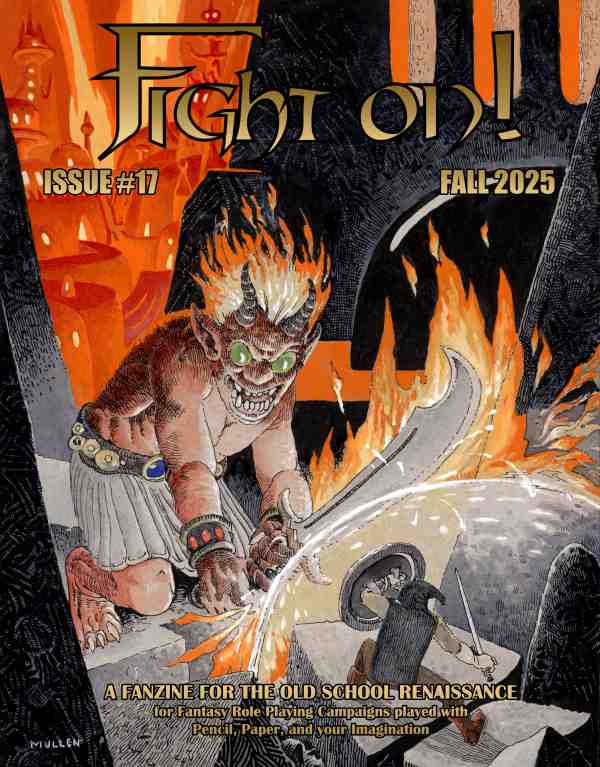News: Fight On! issue 17 now available
Fight On! issue 17 now available on DTRPG and Lulu (POD and PDF)!
Massive issue counting 164 pages (!)—twelve pages more than the titanic third issue—featuring adventures, monsters, classes, artwork, and essays from over thirty contributors. Scroll down for full table of contents.
I contributed 7 Contrarian Practices for Running Online Games essay, outlining practices from our long-running sandbox game. This is a continuation of the 21 Lessons Learned After Running 100 Sessions essay published in the previous issue, which resonated with many readers. Several wrote to me and asked if I could write more about how we play online.

Bigger than a bull baluchitherium barreling through Bucklebury, Fight On! is BACK! Writers and artists old and new proudly present a whopping 166 PAGES of men, magic, monsters, treasures, underworlds, and wilderness adventures for your dreamworld delectation! It’s never been a better day to Fight On!
Discerning dungeoneers and daring dilettantes alike will be DAZZLED with articles, adventures, and art by Toren Atkinson, Attronarch, Zhu Baijee, Rick Base, J. Blasso-Gieseke, Calithena, Paul Carrick, Dr. John Cichowski, Jasmine Collins, Geoffrey O. Dale, Patrick Farley, Graphite Prime, Idle Doodler, Kelvin Green, Allan Grohe, Philipp H., Dave Hargrave, Cameron Hawkey, Kesher, Gabor Lux, Ripley Matthews, James Maliszewski, James Mishler, Michael Mornard, Peter Mullen, Prince of Nothing, Steve Queen, Glenn Robinson, DeWayne Rogers, Frank Scacalossi, Daniel Scherrey, Robert Scudder, Settembrini, Dan Sousa, Oakes Spalding, Anthony Stiller, Paul Swanlund, Del Teigeler, Andrew Walter, Bill Webb, Jennifer Weigel, Alex Zisch, and many more! Don’t delay – score your copy today!
Here is the table of contents:
| Article | Author(s) | Page |
|---|---|---|
| Reptiles and Samurai | Calithena | 5 |
| Martial Stances | Jeff Hollifield | 12 |
| Grognard’s Grimoire: Codex of Droon | Matt the Bastard DM | 14 |
| Knights & Knaves: Stumble | Paul Swanlund | 18 |
| New Kindred for Tunnels & Trolls! | Kesher | 20 |
| Return of the Ancients | Prince of Nothing | 22 |
| Creepies & Crawlies: The Thoul | Allan Grohe | 42 |
| Spiders, Spiders, Spiders! | James Mishler | 50 |
| Lobogolem “Laster” | Del L. Beaudry | 61 |
| Gems of Zylarthen, Part II | Oakes Spalding | 62 |
| Black Powder Firearms | Jack Griffis | 68 |
| Artifacts, Adjuncts, & Oddments | Various | 72 |
| The Eshkom District | James Maliszewski | 75 |
| Under Samora: Al’Murtok’s Refuge | Philipp H. | 85 |
| Contrarian Practices Online | Attronarch | 101 |
| Running for Large Groups | Bill Web | 103 |
| Portal Fantasy Protagonists | Will Mistretta | 105 |
| Saint Cuthbert of Lindisfarne | H. Kazantzakis | 108 |
| The Charioteer’s Shrine | Gabor Lux | 111 |
| Tables for Fables | Reilly, Koed & Blasso-Gieseke | 116 |
| Lady Omen’s Island | Glenn Robinson | 122 |
| Memories of Dave Sutherland | Michael Mornard | 143 |
| Demonweb Savanna | Alex Zisch | 145 |
| Rose Bush Hedge Maze | Geoffrey O. Dale | 151 |
| Chainmail / Sarissa: Fomalhaut | Settembrini / Gabor Lux | 155 |
| Doxy, Urgent Care Cleric | Linneman / Green | 162 |
| Humor & Art | J. B-G, Cal, Queen, and Scherrey | 163 |
Back issues are available via DTRPG and Lulu.
Subscribe to get the latest post in your inbox. No spam.











